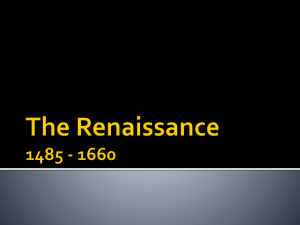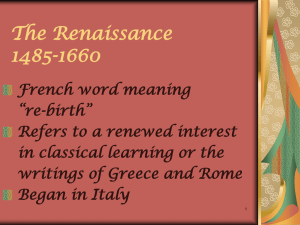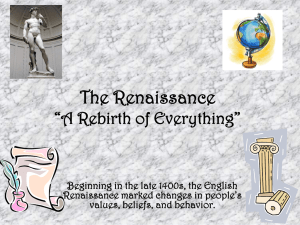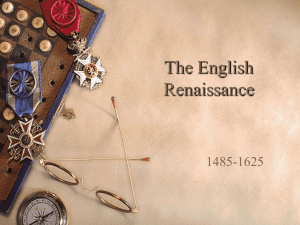The Renaissance
advertisement
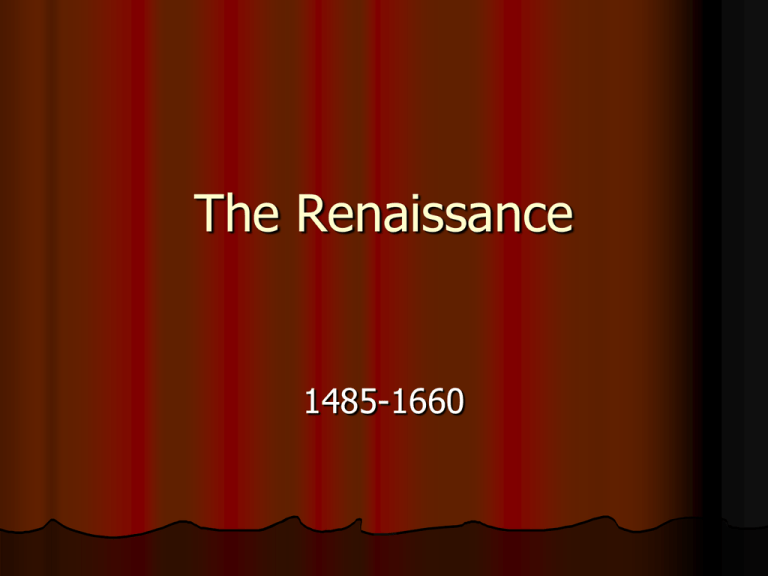
The Renaissance 1485-1660 The Spirit of Rebirth Renaissance – a French word meaning “rebirth” Renewed interest in classical learning, the writings of ancient Greece and Rome A renewal of the human spirit, of curiosity and creativity A Flourish of Genius Began in Italy Leonardo da Vinci, Michelangelo, Christopher Columbus, Galileo, etc. Catholic Church was very rich and powerful, even in political affairs Optimistic view of humanity was expressed by many Renaissance artists Humanism Tried to answer questions like “What is a good life?” and “How do I lead a good life?” Sought to harmonize the Bible and the classics, using the classics to strength (not discredit) Christianity The New Technology Gutenberg invented the printing press Before the printing press, books were written out by hand (difficult process, expensive to purchase, and few books were available) The Reformation Rejected the authority of the pope and the Italian churchmen Feelings of patriotism and national identity made the English resent the financial burdens placed on them by the Vatican Martin Luther – founded a new kind of Christianity, based on a personal understanding of the Bible instead of on what the pope said King Versus Pope King Henry VIII asked for a divorce from his wife of 24-years theoretical reason – she had previously been married to his brother real reasons – she was too old to give him a male heir and he wished to marry Anne Boleyn Pope refused because he was controlled by the queen’s nephew. Henry VIII appointed a new archbishop and declared himself head of the English (Anglican) Church. The Protestant Reformation Many people were dissatisfied with the new church because it wasn’t reformed enough – it was merely a copy of Catholicism. Some said that religion was solely a matter between the individual and God Henry VIII Had six wives: Divorced, beheaded, died divorced, beheaded, survived Fooled around, but couldn’t tolerate any suspicion of his wives’ fidelity Was an important figure and deserves the title of Renaissance man Survived by three legitimate children – Mary, Elizabeth, and Edward The Boy King and Bloody Mary At age 9, Edward began to rule in name only. Died of tuberculosis. Mary was Catholic and determined to avenge the wrongs done to her mother. Restored the pope’s power in England and ruthlessly hunted down Protestants Burned about 300 subjects at the stake Married the king of Spain, a country England was beginning to fear and hate Elizabeth: The Virgin Queen One of the most brilliant and successful monarchs in history Reestablished the Church of England and rejected the pope’s authority Resisted marriage and officially remained “the Virgin Queen” because her strength lay in her independence and her ability to play one suitor off another. A True Daughter Survived many plots against her life, several of which were initiated by her cousin, Mary Stuart, Queen of Scots (heir to England’s throne) Elizabeth (after 20 years of plots against her life) had Mary beheaded The Spanish Armada King Philip of Spain used Mary’s execution as an excuse to invade England with the Spanish Armada England’s Royal Navy destroyed the Spanish Armada, assuring England’s independence from the Catholic countries A Dull Man Succeeds a Witty Woman Elizabeth (childless) was succeeded by James VI of Scotland, aka James I of England (son of Mary Stuart) He tried hard – patronized Shakespeare, sponsored a new translation of the Bible, and was a peaceful ruler – but couldn’t follow in Elizabeth’s footsteps. The Decline of the Renaissance Charles I, who reigned after James I, was beheaded by some of his subjects Parliament and Puritan dictator Oliver Cromwell ruled for the next 11 years Scientific truths were soon to challenge long-accepted religious beliefs.

